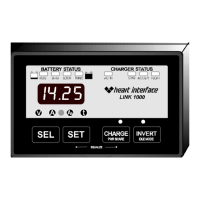02/11/98
29
HIGH DISCHARGE RATES
& PEUKERT'S EQUATION
Peukert's Equation describes the effect of different discharge rates on bat-
tery capacity. As the discharge rate increases the available battery capacity decreases.
The tables on pages 30, 31 & 32 have typical values of "n" for common batteries. Page
30 is a look-up table, pages 31 & 32 have "n" values for common batteries, and page 32
has the formula for calculating "n" for other batteries.
The
Link 1000
uses Peukert's equation only for calculating the Time Remaining
function and for the light bar display. The Amp hours display is always the actual number
of A hrs consumed. This means that if you heavily discharge a battery, your time remain-
ing display may show zero hours remaining before the expected number of A hrs of
battery capacity is consumed.
Making two discharge tests, one at a high discharge rate (I
1
and t
1
) and one at a low
rate (I
2
and t
2
) , that bracket your normal range of operation, allows you to calculate an
"n" which will describe this varying effect. The
Link 1000
uses a default value of "n"
equal to 1.25 which is typical for many liquid cell batteries. Setting Battery Type 1, 2,
(gel cell) or 3 (AGM) changes the Peukert exponent to 1.11, a common exponent for
these type cells.
At some low to moderate discharge rate, typically a battery's 20 hour rate, the
logarithmic effect of Peukert's Equation is greatly reduced. The effect of discharge rates
smaller than this is nearly linear. Battery manufacturer specifications of battery capacity
in Amp-hours is typically given at the 20 hour rate. If a battery is discharged at, or slower
than, the 20 hour rate, you should be able to remove the rated capacity if the battery is
healthy.
The equation for Peukert's Capacity (C
p
) is:
By doing two discharge tests and knowing I
1
& I
2
(discharge current in Amps of the
two tests), and t
1
& t
2
(time in hours for the two tests) you can calculate n (the Peukert
exponent). You will need a calculator with a log function to solve the equation above.
Instead of doing two discharge tests yourself, you may use the 20 hour discharge rate and
the number of reserve minutes as the two discharges to solve Peukert's equation. After
you solve for your Peukert's exponent you may enter it using Advanced Function F08.
C
p
= I
n
t where n =
log
t
2
- log t
1
log I
1
- log I
2

